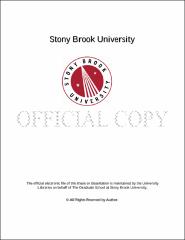| dc.identifier.uri | http://hdl.handle.net/11401/77470 | |
| dc.description.sponsorship | This work is sponsored by the Stony Brook University Graduate School in compliance with the requirements for completion of degree. | en_US |
| dc.format | Monograph | |
| dc.format.medium | Electronic Resource | en_US |
| dc.language.iso | en_US | |
| dc.publisher | The Graduate School, Stony Brook University: Stony Brook, NY. | |
| dc.type | Dissertation | |
| dcterms.abstract | Acoustic source localization and separation are two crucial components in the acoustic signal processing field, which can be utilized in many applications such as smart hearing aids, tracking and surveillance devices. The small form factor of these applications urge the use of miniature sensor arrays. Nonetheless, the performance of traditional localization and separation techniques deteriorate with small-form-factor sensor arrays and they require higher sampling frequency to compensate for the performance loss, which means higher noise floor and more power consumption. Gradient flow is a technique for localization of an acoustic source using miniature microphone arrays by relating temporal and spatial gradients of the impinging source signal. Time delays of the impinging sources can be estimated in this fashion along the two axes in the horizontal plane and the incidence angle can be derived. The performance of the gradient flow in noisy and reverberant environment is examined and quantified through simulations that incorporate additive measurement noise, directional interference signal and room acoustic model. The algorithm demonstrates robust performance for additive signal-to-noise ratio down to 5 dB and at the signal-to-interference ratio of 10 dB. In the echoic room, localization performance remains effective under moderate reverberation conditions. The experimental results from a miniature microphone array recordings in a conference-room environment corroborate the presented simulations. Then I present a subband source separation algorithm for miniature microphone arrays with dimensions smaller than the wavelength. By relating temporal and spatial gradients of the observed microphone signals in an anechoic environment, gradient flow converts the mixture of delayed sources to linear instantaneous mixture of the time-differentiated source signals, that can be then localized and separated using static linear independent component analysis algorithms. For source separation in multi-path environment, I propose subband decomposition of the spatial gradients estimated over an array of 4 microphones. The static ICA algorithms are applied in each frequency band and the localization results obtained from the ICA applied on the unfiltered spatial gradients resolve the scaling and permutation indeterminacy. The simulations with the room acoustic model and experimental results with conference room recordings demonstrate over 12dB separation in moderate reverberation environment. | |
| dcterms.available | 2017-09-20T16:52:45Z | |
| dcterms.contributor | Stanacevic, Milutin | en_US |
| dcterms.contributor | Hong, Sangjin | en_US |
| dcterms.contributor | Salman, Emre | en_US |
| dcterms.contributor | Gouma, Pelagia-Irene. | en_US |
| dcterms.creator | Li, Shuo | |
| dcterms.dateAccepted | 2017-09-20T16:52:45Z | |
| dcterms.dateSubmitted | 2017-09-20T16:52:45Z | |
| dcterms.description | Department of Electrical Engineering. | en_US |
| dcterms.extent | 132 pg. | en_US |
| dcterms.format | Application/PDF | en_US |
| dcterms.format | Monograph | |
| dcterms.identifier | http://hdl.handle.net/11401/77470 | |
| dcterms.issued | 2015-12-01 | |
| dcterms.language | en_US | |
| dcterms.provenance | Made available in DSpace on 2017-09-20T16:52:45Z (GMT). No. of bitstreams: 1
Li_grad.sunysb_0771E_12287.pdf: 7526685 bytes, checksum: 54613a3370b8bc155ef481b0616bd29e (MD5)
Previous issue date: 1 | en |
| dcterms.publisher | The Graduate School, Stony Brook University: Stony Brook, NY. | |
| dcterms.subject | Electrical engineering | |
| dcterms.title | Smart Sensing: Mixed-Signal VLSI Implementation of Gradient Flow Localization and Separation | |
| dcterms.type | Dissertation | |

